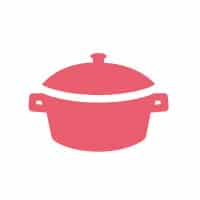Korean spicy chicken has captured the hearts of home cooks around the world, and for good reason! This comforting, spicy dish brings together tender chicken, fresh vegetables, and bold Korean flavors in one satisfying pot.
Traditional recipes like Dakbokkeumtang (spicy braised chicken) and Dakdoritang (Korean chicken stew) have been warming Korean families for generations, offering the perfect balance of heat, umami, and comfort.
Home cooks are increasingly drawn to these delicious Korean dishes because they deliver restaurant-quality flavors using readily available ingredients and straightforward techniques.
Korean chicken stew recipes create hearty, soul-warming meals that work perfectly for family dinners, cold-weather comfort food, or when you want to explore the rich culinary traditions of Korea.
What Makes Korean Chicken Stew Special?
Korean chicken stew stands out from other chicken dishes due to its distinctive use of gochujang (Korean chili paste), which provides both heat and a deep, complex flavor.
The cooking method involves braising chicken pieces with vegetables in a savory-spicy sauce that develops incredible depth over time.
Traditional Korean chicken stews typically include ingredients like Korean pears, potatoes, carrots, and onions, which balance the spice while adding natural sweetness and texture.
The key difference between Dakbokkeumtang and Dakdoritang lies in their preparation methods:
Dakbokkeumtang focuses on braising with less liquid to achieve more concentrated flavors, while Dakdoritang is more soup-like, incorporating additional broth.
Main Ingredients For the RecipeFor the Chicken:
For the Stew Base:
For Aromatics and Vegetables:
|
Recipe Information
| Detail | Information |
|---|---|
| Prep Time | 20 minutes |
| Cook Time | 45 minutes |
| Total Time | 1 hour 5 minutes |
| Difficulty | Intermediate |
| Servings | 4-6 people |
| Storage | 4 days refrigerated |
| Course | Main Dish |
| Cuisine | Korean |
Step-by-Step Korean Chicken Stew Recipe
Mastering Korean chicken stew requires understanding the layering of flavors and proper timing. Follow these detailed steps to create a traditional dish that rivals your favorite Korean restaurant.
Step 1: Prepare the Chicken
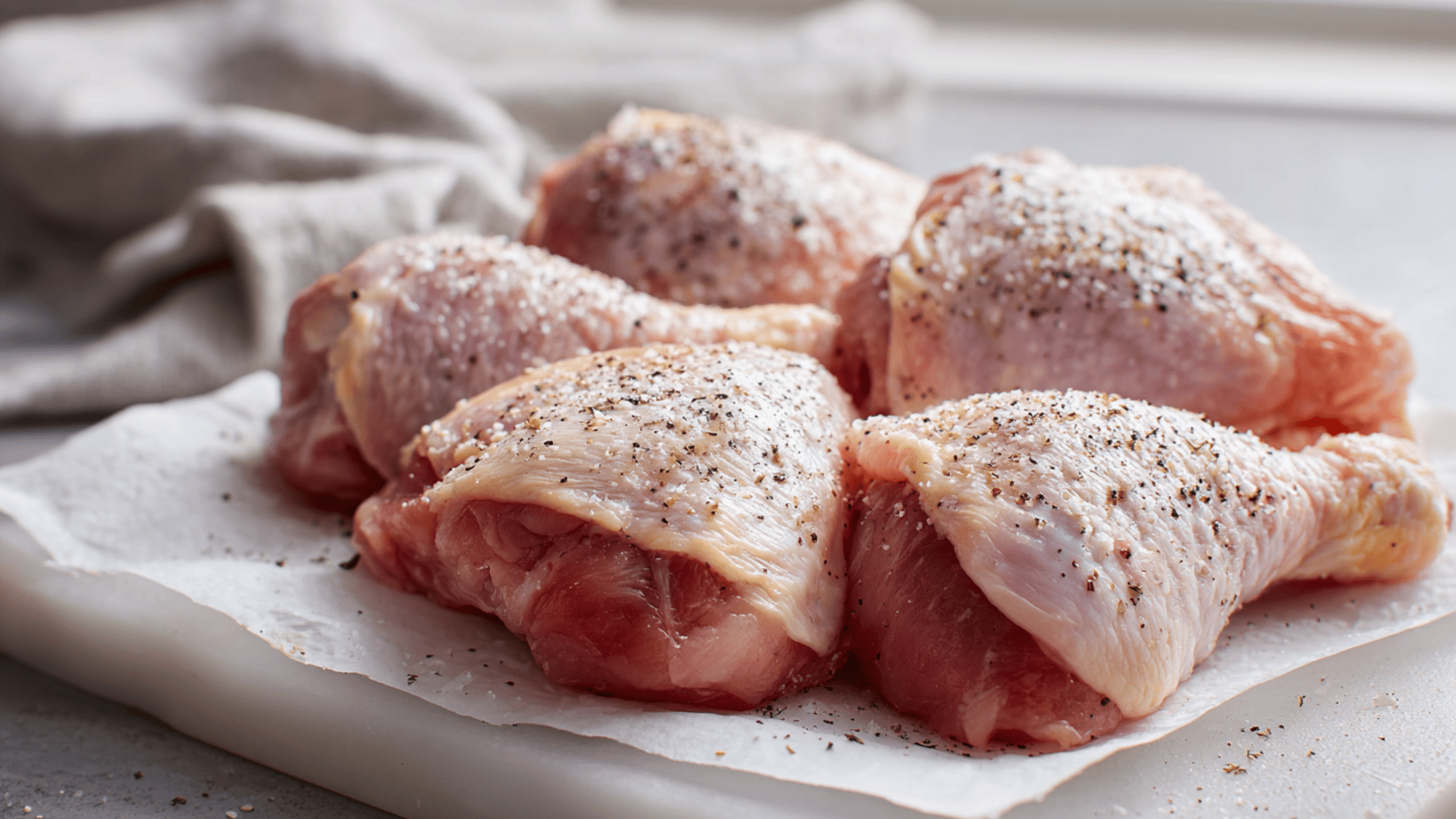
Clean the chicken pieces thoroughly and pat them dry with paper towels. Season lightly with salt and white pepper, then let them come to room temperature for 15 minutes.
Cut larger pieces if needed to ensure even cooking. Removing excess skin is optional, but it reduces grease in the final dish.
Pro Tip: Soaking chicken pieces in cold salted water for 30 minutes before cooking removes any remaining blood and ensures cleaner flavors.
Step 2: Brown the Chicken
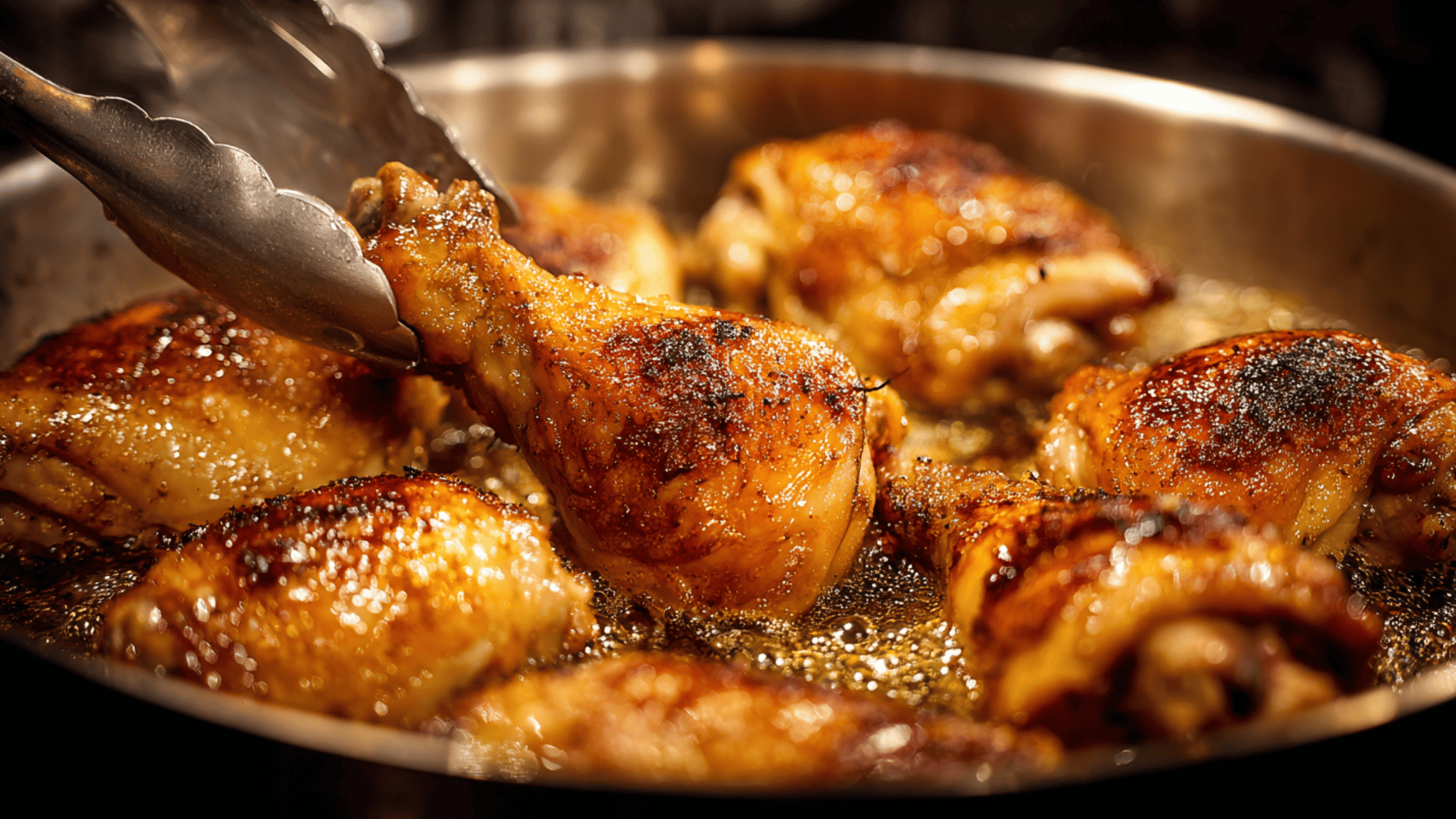
Heat vegetable oil in a heavy-bottomed pot or Dutch oven over medium-high heat. Brown the chicken pieces on all sides, about 3-4 minutes per side, working in batches to avoid overcrowding.
The goal is to develop color and flavor, not fully cook the chicken. Remove browned pieces to a plate and set aside.
Pro Tip: Don’t skip this browning step, it creates the foundation of flavor for your entire stew.
Step 3: Build the Flavor Base
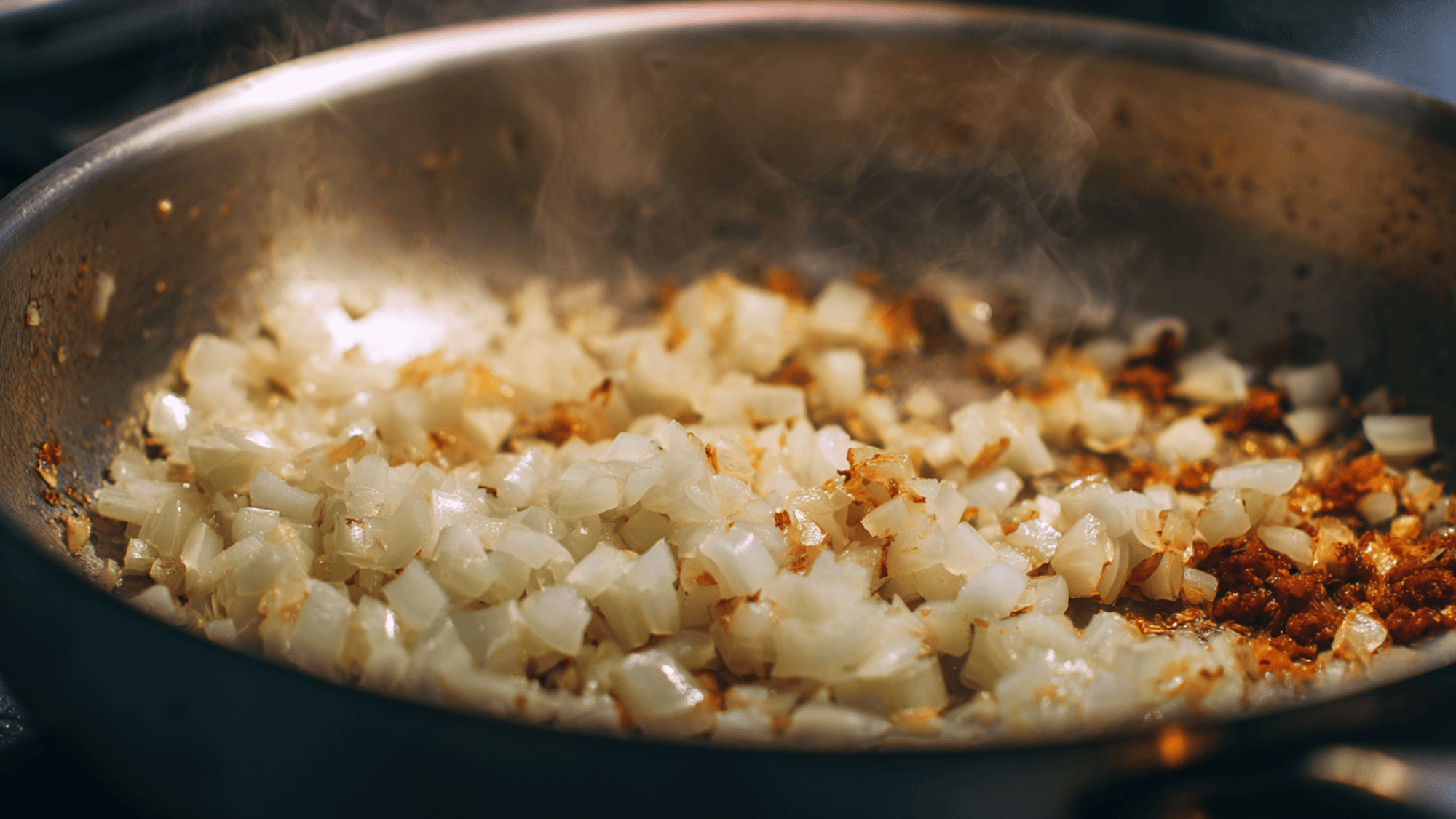
In the same pot, reduce the heat to medium and add the onions, cooking until they are softened, about 5 minutes. Add garlic and ginger, cooking for another minute until fragrant.
Stir in the gochujang, coating the aromatics, and cook for 2 minutes to develop the paste’s flavors. Add soy sauces and rice wine, scraping up any browned bits from the bottom.
Pro Tip: Briefly cooking the gochujang removes any raw taste and intensifies its flavors.
Step 4: Add Liquid and Vegetables

Return chicken to the pot and add chicken stock, ensuring pieces are mostly covered. Bring to a boil, then reduce the heat and simmer for 20 minutes.
Add potatoes, carrots, and Korean pear, arranging them around the chicken. Continue cooking for an additional 15-20 minutes, or until the vegetables are tender and the chicken is cooked through.
Pro Tip: Add vegetables in stages based on their cooking times to prevent overcooking.
Step 5: Final Seasoning and Garnish
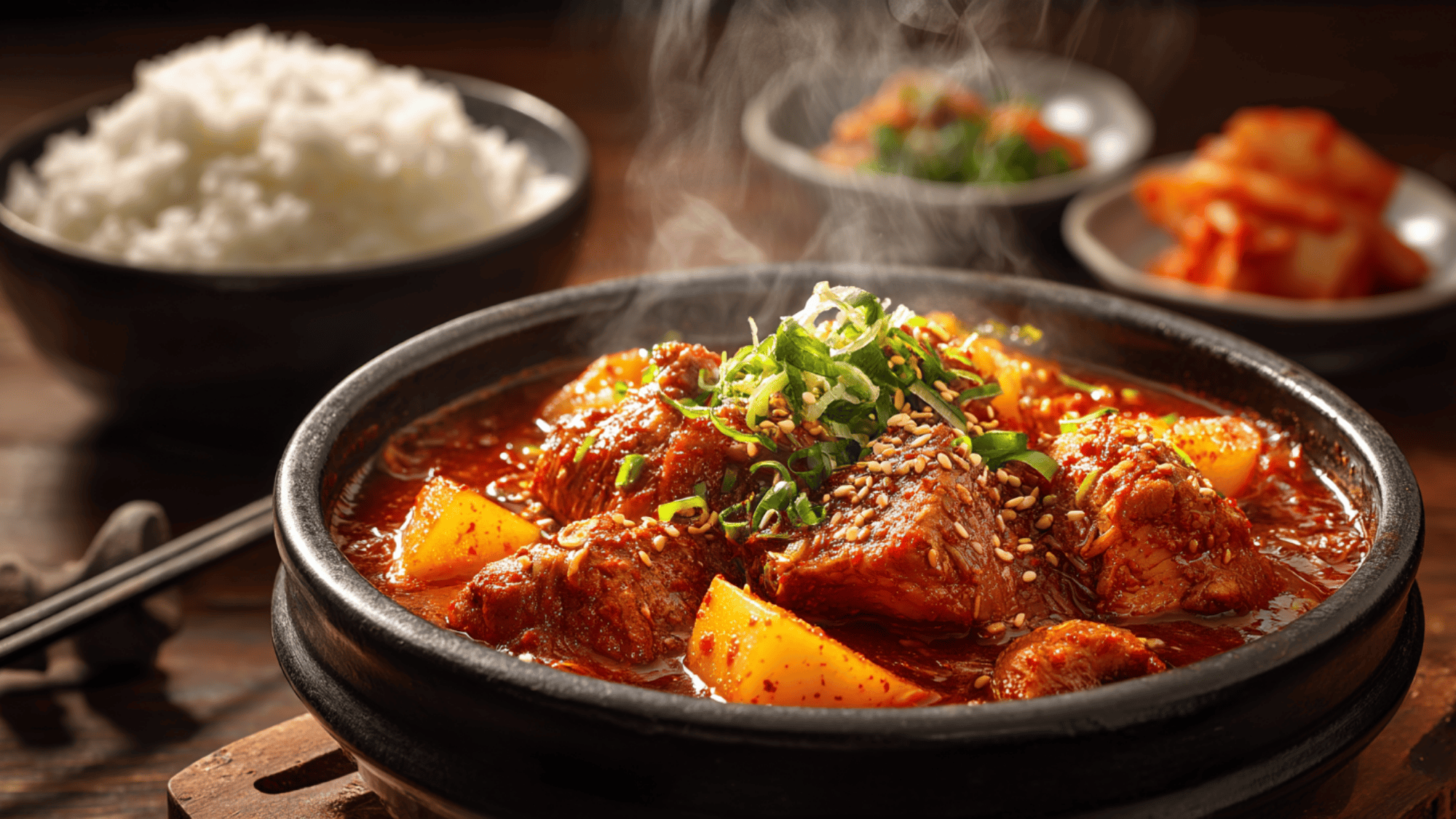
Taste the stew and adjust seasoning with additional gochujang for heat or soy sauce for saltiness. Stir in green onions and bell peppers during the last 5 minutes of cooking.
Finish with a drizzle of sesame oil and garnish with additional chopped green onions before serving over steamed rice.
Pro Tip: Let the stew rest for 5 minutes before serving to allow flavors to settle and sauce to thicken slightly.
Nutritional Benefits of Korean Chicken Stew
Korean chicken stew provides substantial nutrition while delivering traditional flavors. The combination of lean protein, vegetables, and beneficial spices creates a well-balanced meal.
| Nutrition Facts | Per Serving (400g) |
|---|---|
| Calories | 425kcal |
| Protein | 35g |
| Carbohydrates | 28g |
| Fat | 19g |
| Fiber | 4g |
| Sodium | 890mg |
Note: Nutritional values may vary depending on the specific ingredients and cooking methods used. Korean chicken stew provides complete proteins and beneficial compounds from gochujang!
Storage and Reheating Guidelines
Proper storage maintains the flavors and safety of your Korean chicken stew for future meals. Here are the best practices for keeping your stew delicious.
Immediate Storage:
- Cool completely within 2 hours of cooking
- Store in airtight containers for up to 4 days refrigerated
- Freeze portions for up to 3 months
- Label containers with preparation dates
Reheating Methods:
- Stovetop: Heat gently over low heat, adding water if needed
- Microwave: Heat in 1-minute intervals, stirring between
- Oven: Cover and reheat at 325°F for 20-25 minutes
Pro Tip: Korean stew often tastes even better the next day, as flavors continue to develop, making it perfect for meal prep.
Traditional Variations and Regional Styles
Korean chicken stew varies across regions and families, with each bringing unique ingredients and techniques that reflect local preferences and the availability of ingredients.
1. Dakdoritang Style (Soupy Version)
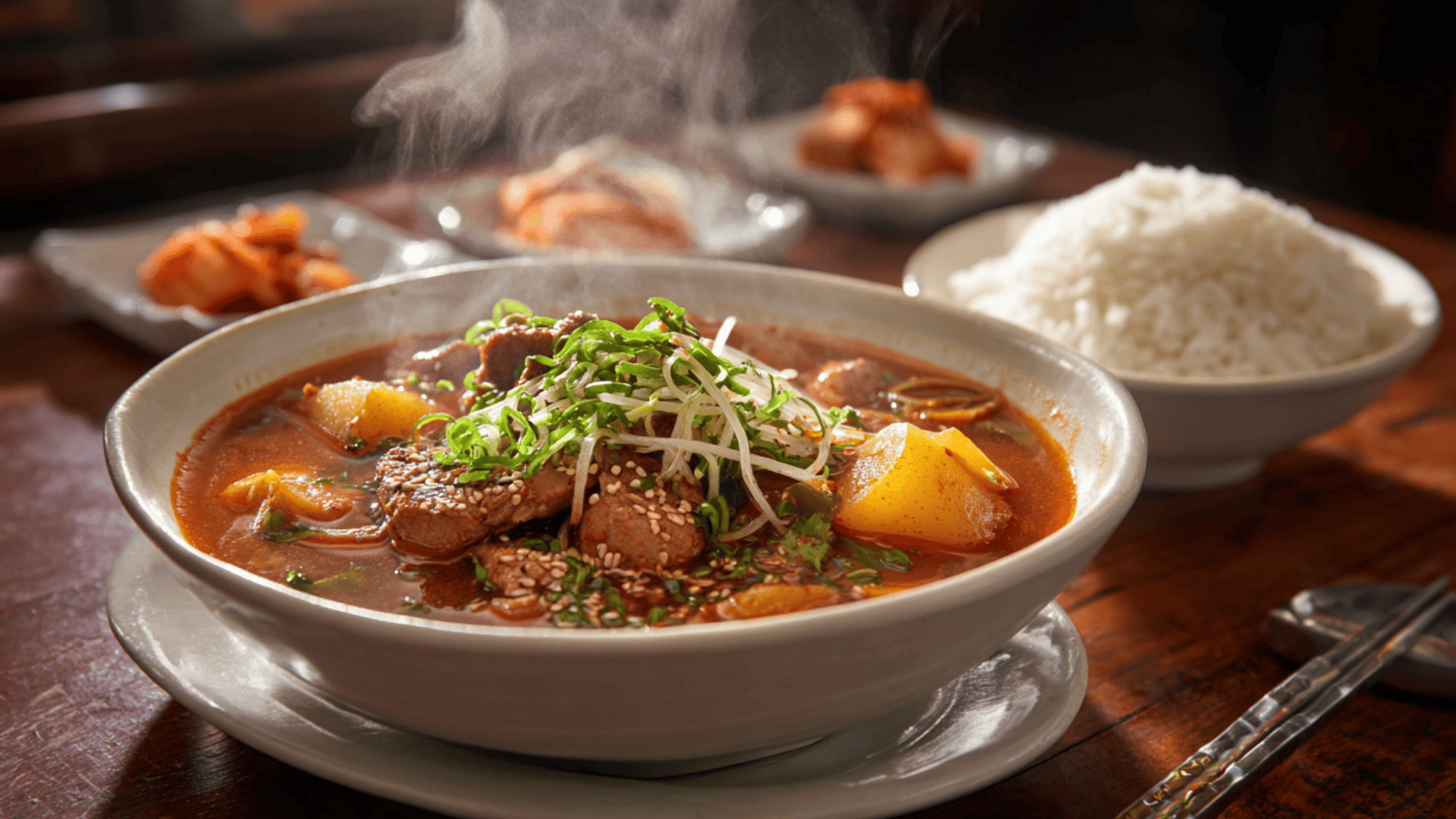
Traditional dakdoritang features a richer broth, resulting in a soup-like consistency that is perfect for serving over rice. This version often includes Korean glass noodles and additional vegetables, such as mushrooms and bean sprouts.
The extra liquid makes it ideal for sharing and creates a more comforting, soup-like experience that’s perfect for cold weather.
| Ingredient | Amount | Notes |
|---|---|---|
| Base recipe ingredients | As above | Same base recipe |
| Extra chicken stock | 2 cups | Makes it more soup-like |
| Korean glass noodles | 4 oz | Soak before adding |
| Mushrooms | 1 cup | Shiitake or oyster |
| Bean sprouts | 1 cup | Fresh |
How to Make:
- Follow the base recipe steps 1-9, then add extra chicken stock to achieve a soupy consistency.
- Add soaked glass noodles and mushrooms after 15 minutes of simmering.
- Add bean sprouts during the last 3 minutes to keep them crisp.
- Adjust seasoning and serve with extra broth in bowls.
- Garnish with green onions and serve immediately over rice.
2. Andong-Style Preparation
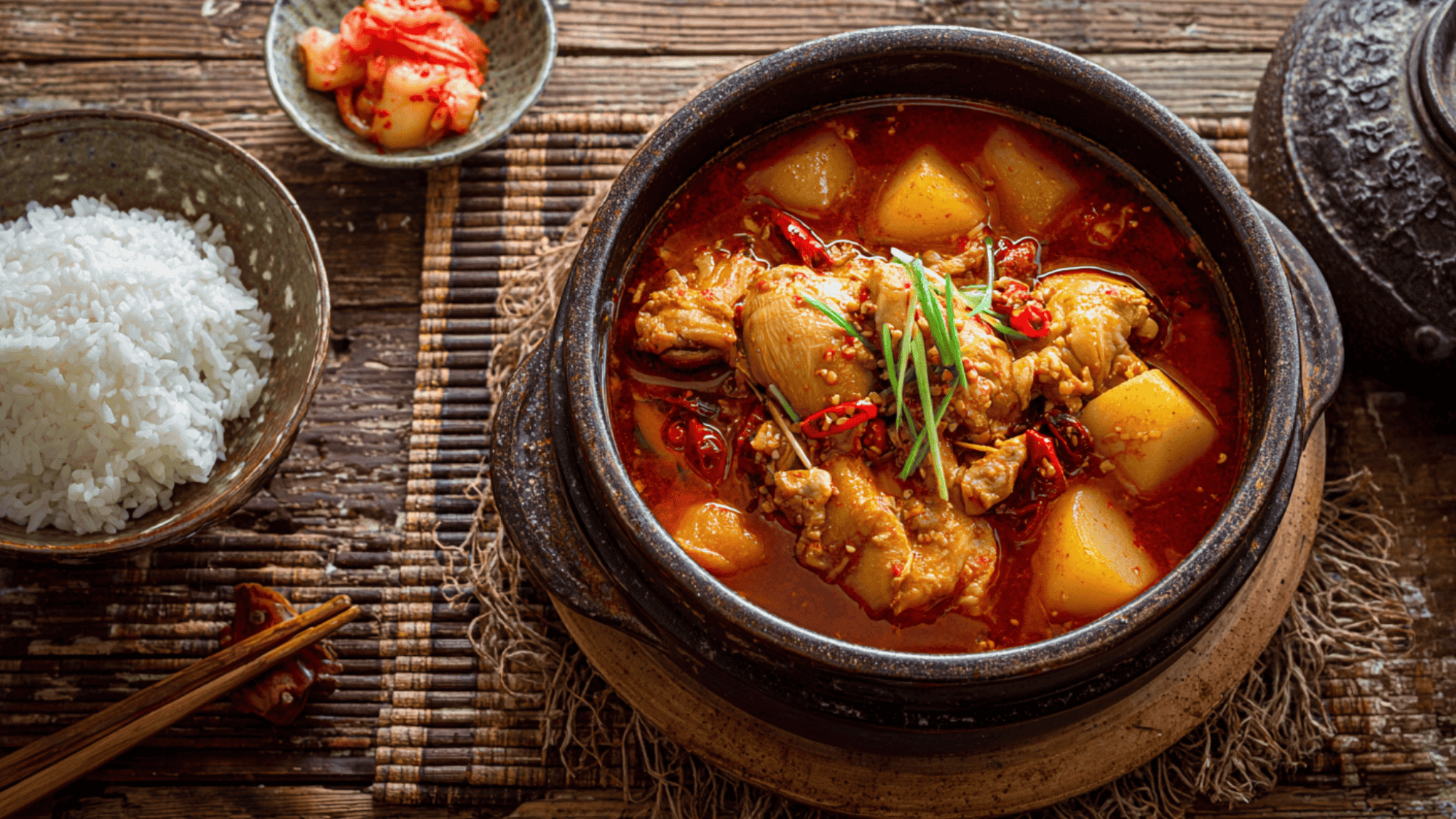
The Andong region adds dried red peppers and uses less gochujang, creating a cleaner, more straightforward spice profile. This version highlights the natural chicken flavors with minimal sauce.
Traditional Andong preparation often features Korean radish and utilizes homemade chicken stock for richer flavors.
| Ingredient | Amount | Notes |
|---|---|---|
| Base recipe ingredients | As above | Reduce gochujang to 1 tbsp |
| Dried red peppers | 4-5 pieces | Korean dried peppers |
| Korean radish | 2 cups | Cut into chunks |
| Homemade chicken stock | 3 cups | Replace store-bought |
| Korean pear | 2 medium | Extra sweetness |
How to Make:
- Brown chicken and build a base with less gochujang, and add dried red peppers.
- Use homemade chicken stock and add Korean radish with other vegetables.
- Simmer longer (30 minutes) to develop cleaner, deeper flavors.
- Add an extra Korean pear for natural sweetness to balance the spice.
- Finish with sesame oil and serve with minimal garnish.
3. Modern Fusion Adaptations
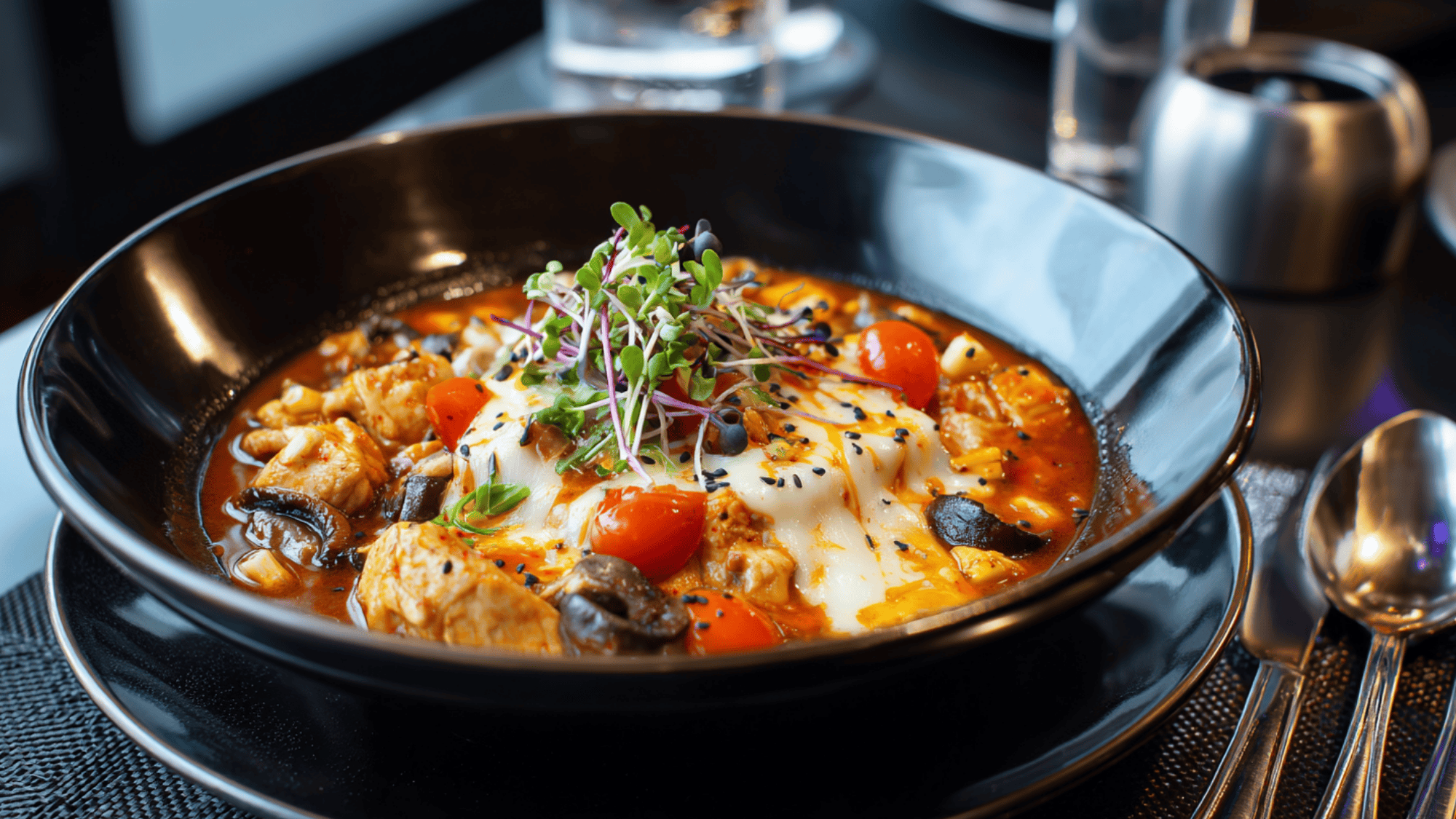
Contemporary Korean home cooks sometimes incorporate ingredients like mushrooms, corn, or cheese, creating fusion versions that appeal to diverse tastes while preserving the core Korean flavors.
These adaptations show how traditional recipes change while respecting their cultural roots and essential flavor profiles.
| Ingredient | Amount | Notes |
|---|---|---|
| Base recipe ingredients | As above | Standard base |
| Mixed mushrooms | 2 cups | Cremini, shiitake, oyster |
| Corn kernels | 1 cup | Fresh or frozen |
| Mozzarella cheese | 1 cup | Shredded |
| Cherry tomatoes | 1 cup | Halved |
How to Make:
- Follow the base recipe through step 10, then add mixed mushrooms with vegetables.
- Add corn kernels during the last 10 minutes of cooking.
- Stir in cherry tomatoes during the last 5 minutes to keep them firm.
- Top with shredded mozzarella cheese just before serving.
- Let the cheese melt slightly and serve immediately with rice.
4. Vegetable-Forward Versions
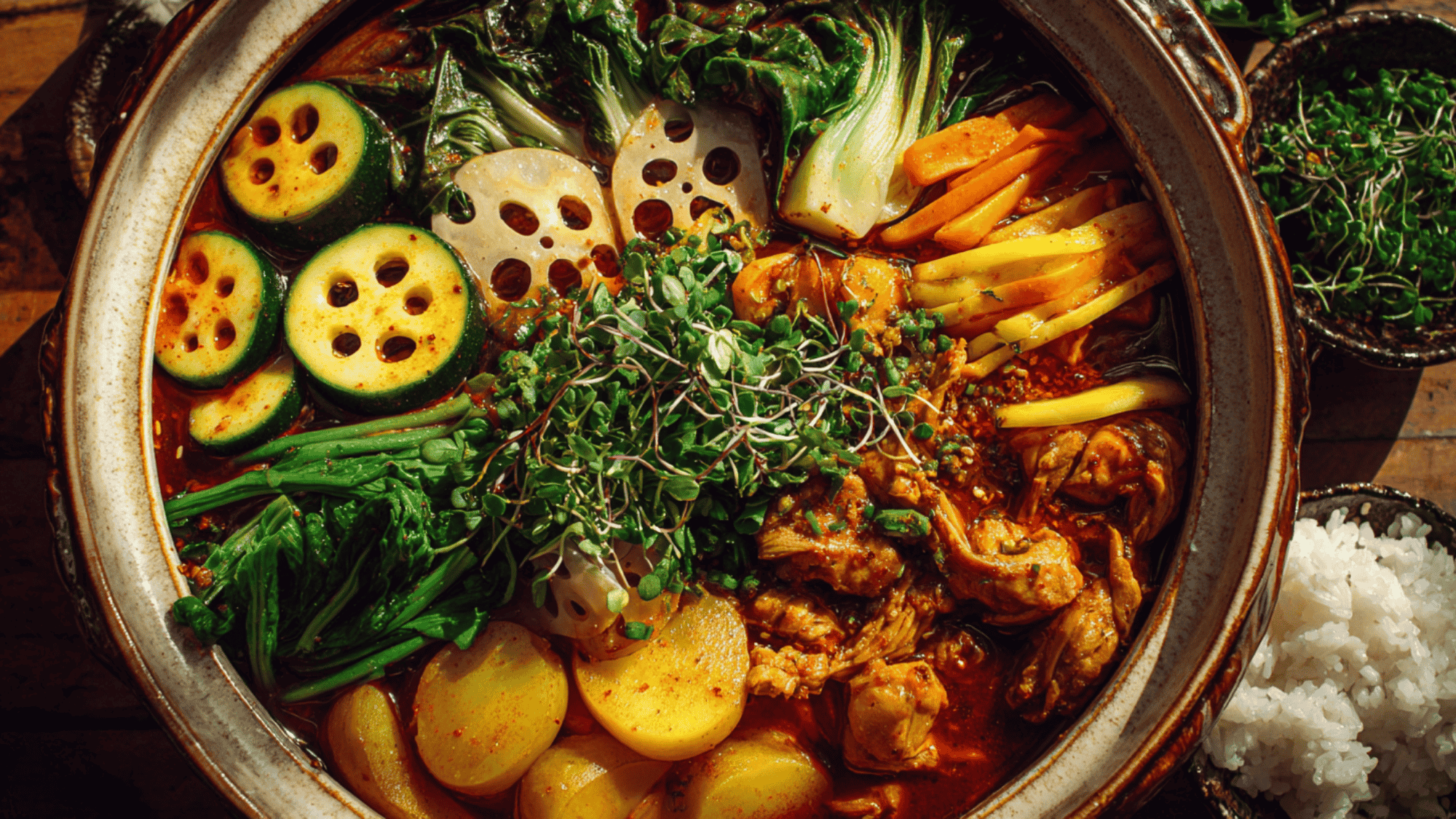
Some families increase the vegetable content, adding items like Korean cabbage, zucchini, or lotus root for additional nutrition and varied textures.
This approach creates a more balanced dish while maintaining the traditional Korean flavor profile that makes the stew so satisfying.
| Ingredient | Amount | Notes |
|---|---|---|
| Base recipe ingredients | As above | Same base recipe |
| Korean cabbage | 2 cups | Chopped |
| Zucchini | 1 medium | Cut into half-moons |
| Lotus root | 1 cup | Sliced thin |
| Korean spinach | 2 cups | Fresh |
How to Make:
- Follow the base recipe steps 1-9, reducing the chicken to 2 lbs to make room for the vegetables.
- Add lotus root, potatoes, and carrots for a longer cooking time.
- Add Korean cabbage and zucchini during the last 10 minutes of cooking.
- Stir in fresh spinach during the final 2 minutes until wilted.
- Adjust the seasoning and serve with extra vegetables prominently featured in each bowl.
Final Thoughts
Korean chicken stew represents the heart of Korean home cooking – bold flavors, warming spices, and ingredients that bring families together around the table.
These traditional recipes connect us to centuries of Korean culinary wisdom, providing practical and delicious meals for modern life.
The balance of spicy gochujang, tender chicken, and fresh vegetables creates a dish that satisfies both comfort food cravings and nutritional needs.
If you opt for the brothier Dakdoritang or the more concentrated Dakbokkeumtang, Korean chicken stew offers a traditional taste of Korea that you can recreate in your own kitchen.
So gather your gochujang, prepare your vegetables, and start your own tradition with this warming, spicy, and utterly satisfying Korean chicken stew!



